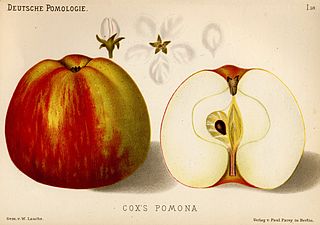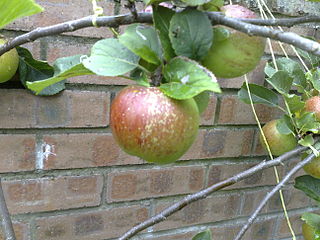Related Research Articles

Fruit tree propagation is usually carried out vegetatively (non-sexually) by grafting or budding a desired variety onto a suitable rootstock.

Malus is a genus of about 30–55 species of small deciduous trees or shrubs in the family Rosaceae, including the domesticated orchard apple – also known as the eating apple, cooking apple, or culinary apple. The other species are commonly known as crabapples, crab apples, crabtrees, wild apples, or rainberries.

Pollination of fruit trees is required to produce seeds with surrounding fruit. It is the process of moving pollen from the anther to the stigma, either in the same flower or in another flower. Some tree species, including many fruit trees, do not produce fruit from self-pollination, so pollinizer trees are planted in orchards.
A rootstock is part of a plant, often an underground part, from which new above-ground growth can be produced. It could also be described as a stem with a well developed root system, to which a bud from another plant is grafted. It can refer to a rhizome or underground stem. In grafting, it refers to a plant, sometimes just a stump, which already has an established, healthy root system, onto which a cutting or a bud from another plant is grafted. In some cases, such as vines of grapes and other berries, cuttings may be used for rootstocks, the roots being established in nursery conditions before planting them out. The plant part grafted onto the rootstock is usually called the scion. The scion is the plant that has the properties that propagator desires above ground, including the photosynthetic activity and the fruit or decorative properties. The rootstock is selected for its interaction with the soil, providing the roots and the stem to support the new plant, obtaining the necessary soil water and minerals, and resisting the relevant pests and diseases. After a few weeks, the tissues of the two parts will have grown together, eventually forming a single plant. After some years, it may be difficult to detect the site of the graft although the product always contains the components of two genetically different plants.

Charles Downing, was an American pomologist, horticulturist, and author.
Cecil Frederick Patterson (1891–1961) was renowned in Saskatchewan for his work on hardy fruits and flowers.

Grafting or graftage is a horticultural technique whereby tissues of plants are joined so as to continue their growth together. The upper part of the combined plant is called the scion while the lower part is called the rootstock. The success of this joining requires that the vascular tissues grow together and such joining is called inosculation. The technique is most commonly used in asexual propagation of commercially grown plants for the horticultural and agricultural trades.

'Discovery' is an early season dessert apple cultivar. One of its parents was the 'Worcester Pearmain', with the pollinator thought to possibly be 'Beauty of Bath'.
Niels Ebbesen Hansen was a Danish-American horticulturist, botanist, and agricultural explorer for the United States Department of Agriculture and the state of South Dakota. He searched the harsh environments of northern Scandinavia, Siberia, Manchuria, and the dry steppes of the Volga for plant stock that could flourish on the upper Great Plains.

The 'York Imperial', or 'York', is a cultivar of apple from which a number of other valuable strains and cultivars have arisen, including four sport varieties: Commander York, Ramey York, Red Yorking, and Yorking.

A 'Stayman' is a triploid apple cultivar developed in 1866 by Joseph Stayman of Leavenworth County, Kansas; it was sold by nurseries from 1895. 'Stayman' apples remain a locally popular cultivar of apples where grown.

The 'Laxton's Superb' is an apple cultivar that was developed in England in 1897. It is a cross breed between Cellini and 'Cox's Orange Pippin' and is not a cross between Wyken Pippin and Cox Orange Pippin. It is a British apple with a green color and a dull red flush. It is a firm-textured dessert apple. The fruit is well known for its sweet and aromatic taste which is likened to the parent species it is derived from, the 'Cox's Orange Pippin'. Density 0,82 g/cc, sugar 14,0%, acid 7,4 g/litre. Vitamin C 9mg/100g.

Felix Gillet was a California pioneer nurseryman, horticulturist, sericulturist, and writer who made several important introductions of superior European deciduous fruit and nut trees to California and the northwestern United States. Beginning in 1869, in his Barren Hill Nursery in Nevada City, Gillet cultivated his own imported scion wood and home-grown nursery stock, experimented with grafting and hybridizing, and continually wrote articles on horticulture and his plant selections, while remaining active in Nevada City civic affairs. Publishing his own nursery catalog for 37 years and advertising widely, he sold his walnuts, filberts (hazelnuts), chestnuts, prunes, figs, strawberries, grapes, peaches, cherries, citrus and dozens of other fruit and nut varieties throughout California and the Pacific Northwest. The commercial walnut variety "Felix Gillet" was named in his honor.

Richard Cox was an English brewer and horticulturist who bred the apple varieties Cox's Orange Pippin and Cox's Pomona.
The Minnesota State Horticultural Society (MSHS), with headquarters in Roseville, Minnesota, is a nonprofit membership organization that provides education and resources to northern gardeners in the United States. It publishes Northern Gardener, a bi-monthly magazine that is the only U.S. publication devoted exclusively to gardening in Hardiness Zones 3-5. Its "Garden-in-a-Box" program provides raised bed garden boxes, along with soil and vegetable plants, to low-income families and schoolchildren in the greater Minneapolis and St. Paul, Minnesota area and elsewhere in Minnesota. "Minnesota Green" is a MSHS program that coordinates donations of plant material from growers, garden centers, and individuals to public space and community gardens. MSHS offers classes year-round on gardening subjects. MSHS currently has 10,000 members and subscribers to its publication.

Laxton Brothers was a business founded by Edward Augustine Lowe Laxton MBE (1869–1951) and William Hudson Lowe Laxton (1866–1923) who were notable horticulturists, pioneers of plant breeding and experts on fruit production creating several new strains of fruit such as 'Laxtonberry', 'Laxton's Delicious' plum tree, Laxton's No.1 red currant, Laxton’s Superb apples and the award-winning Lord Lambourne apple.
The Cambrian Journal contains a list of names for about 200 Welsh apples, the majority of which were from the Monmouth area.
John Samuel Harris was an early American horticulturist, the first person to successfully plant and propagate apple trees in Minnesota, a climate in which it was previously thought that the fruit could not survive the harsh northern U.S winters.
The Pacific Agri-Food Research Centre is an agricultural research centre in British Columbia, Canada. The centre has been historically important in the development of tree fruits. It is administered by Agriculture and Agri-Food Canada and includes sites at Summerland and Agassiz.

Joseph Lancaster Budd was an American professor and horticulturist. He was employed by Iowa State College and was part of the Iowa State Horticultural Society among others. His work involved fruit trees and other plants, but particularly apples.
References
- ↑ The Biennial Report of the Kansas State Horticultural Society (27 ed.). Kansas State Horticultural Society. 1904. p. 15. Retrieved 9 November 2021.
- ↑ "Details of a Stayman fruit tree growing in Battle Ground United States". Orange Pippin - the directory of apples, pears, plums, cherries and orchard fruits.
- ↑ "A History of Wine in America "d0e5753"".
- ↑ http://mrcc.sws.uiuc.edu/FORTS/histories/KS_Leavenworth_Doty.pdf [ dead link ]
Extracted from a publication entitled They Came This Way by J.H. Johnston III available at the Leavenworth County Historical Society.